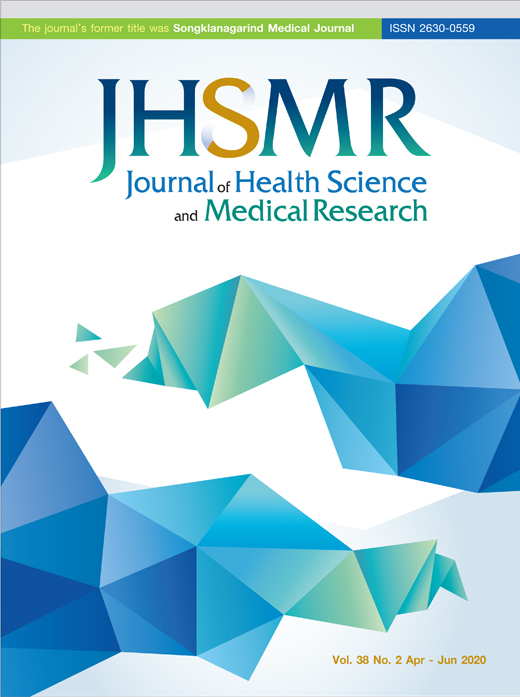Duration after Malayan Pit Viper Bite to Detect Coagulopathy in Songklanagarind Hospital
DOI:
https://doi.org/10.31584/jhsmr.2020728Keywords:
Coagulopathy, Malayan pit viper, venous clotting time, 20-minute whole blood clotting testAbstract
Objective: The main objective was to determine the duration from the bite of a Malayan pit viper (MPV) until a prolonged clotting time in order to create a practice protocol for the Emergency Department (ED) of a university hospital in southern Thailand. The secondary objective was to know the incidence of adverse reactions from the MPV antivenom.
Material and Methods: This was a retrospective descriptive study of patients with MPV bite from 1 January 2006 to 30 November 2017 in the ED at Songklanagarind Hospital.
Results: The study included 153 patients. The average age was 45 years. The median elapsed time from bite to the ED was 40 minutes (interquartile range 30, 80). Fifty nine patients (38.6%) had coagulopathy. The median elapsed time from bite to coagulopathy was 5 hours 30 minutes (range, 40 minutes to 48 hours 40 minutes). Four patients (6.8%) had coagulopathy within the first 2 hours. Thirty patients (50.8%) had coagulopathy within the first 6 hours. Coagulopathy was detected in most of the patients (83.1%) within the first 24 hours. Fifty patients (84.8%) received antivenom. Four patients had immediate hypersensitivity reactions.
Conclusion: The ED protocol should follow-up with a 20-minute whole blood clotting test at 6 hours after a bite to determine the appropriate disposition. If the patients do not have coagulopathy after 6 hours from snake bite, it is safe to follow-up at 24 hours, 48 hours and 72 hours after the bite. The incidence of antivenom hypersensitivity was low
References
Muang Dan C. Snake bite. In: Siripanich S, editor. Annual epidemiological surveillance report 2015. Nonthaburi: Bureau of Epidermiology, National Trustworthy and Competent Authority in Epidemiological Surveillance and Investigation; 2015;p.178.
Butaraj S. Epidemiological study of venonous snakes in Songkhla province. J Commun Dis 1984;10:337-50.
The academic development of Department of Medical Services, The Ministry of Public Health. Practice guideline for management of patients with snake bite. Bangkok: The Agricultural Cooperative Federation of Thailand; 2004.
Regional Office for South-East Asia, World Health Organization. Guidelines for the management of snakebites. 2nd ed. New Delhi: WHO Regional Office for Southeast Asia; 2016.
Laohawiriyakamol S, Sangkhathat S, Chiengkriwate P, Patrapinyokul S. Surgery in management of snake envenomation in children. World J Pediatr 2011;7:361-4.
Wongthongkam N, Wilde H, Sitti-Amorn C, Ratanabananangkoon K. A study of 225 Malayan pit viper bites in Thailand. Mil Med 2005;170:342-8.
Deechaisest P. The outcome of Malayan pit viper (Calloselasma rhodostoma) antivenom in snake bite victims at Na Mom Hospital, Songkhla province, Thailand. J Health Sci 2012;21: 1157-65.
Warrell DA. Guideline for management of snakebite. New Delhi: WHO Regional Office for Southeast Asia; 2010.
Lekhakula A. Management of Malayan pit viper bites. J Hematol Transfus Med 2014;24:163-73.
Warrell DA, Looareesuwan S, Theakston RD. Randomized comparative trial of three mono specific antivenoms for bites by Malayan pit viper (Colloselasma rhodostoma) in southern Thailand: clinical and laboratory correlations. Am J Trop Med Hyg 1986;35:1235-47.
Lee RI, White PD, A clinical study of the coagulation time of blood. Am J Med Sci 1913;145:496–503.
Blessmann J, Khonesavanh C, Outhaithit P, Manichanh S, Somphanthabansouk K, Siboualipha P. Venomous snake bites in Lao PDR: a retrospective study of 21 snakebite victims in a provincial hospital. Southeast Asian J Trop Med Public Health 2010;41:195-202.
Thiansookon A, Rojnuckarin P. Low incidence of early reactions to horse-derived F(ab')(2) antivenom for snakebites in Thailand. Acta Trop 2008;105:203-5.
























